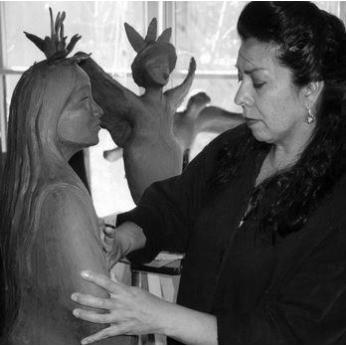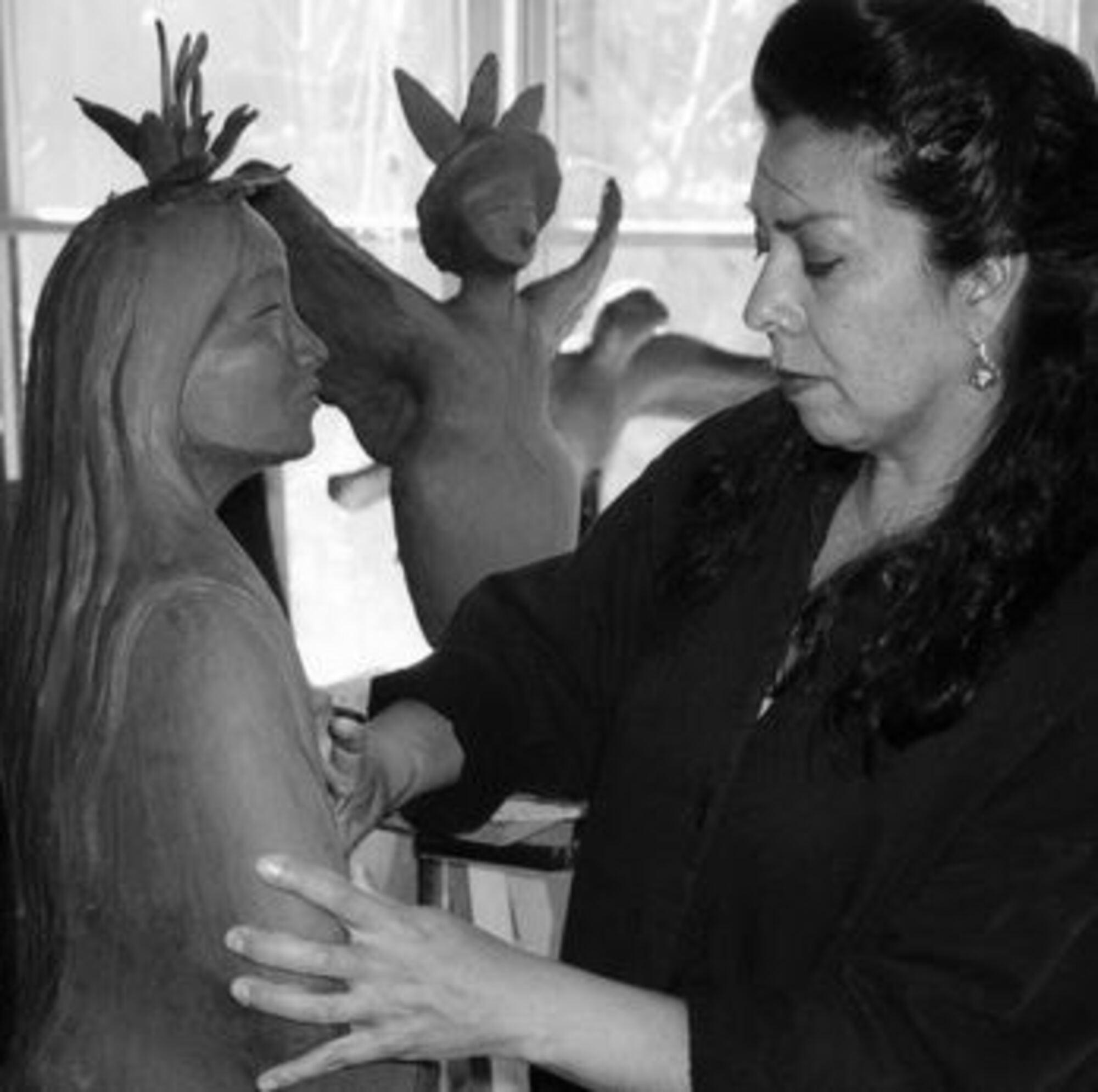
Estella Loretto, 2001.
Photograph by Katrina Lasko. Copyright 2001 School of American Research.
Estella Loretto
Culture: Jemez Pueblo
b. 1954
“When I start a piece of artwork, I am caught up in the sacred process of inspiration and emotion, never knowing exactly where or what it will lead to,” writes Estella Loretto, SAR’s first Rollin and Mary Ella King Native American Artist Fellow.
An innate passion for life and its experiences governs Loretto’s joy of artistic expression. Her passion for life originated at home in Jemez Pueblo where her grandmother and mother were important role models, both participating in the gentle yet demanding tasks of raising a young girl to womanhood. At home Estella found love and respect intermingled with learning the important lessons of a Pueblo woman’s life. These sensibilities guide Estella today in her relationships, and with her daughter, Fawn.
“When I start a piece of artwork, I am caught up in the sacred process of inspiration and emotion, never knowing where or what it will lead to. I am committed to the passion of creative expression. Art is a process that has its own lifeforce and power. I am very moved by the challenge and dedicate my life to it,” says Loretto describing her artistic process.
This commitment to art was nurtured by her attendance at the Institute for American Indian Arts from 1970–1972. She studied under legendary artist Allan Houser, who generously offered to guide the direction of her work. The most important lesson she learned from him was that “an artist shouldn’t work to make money. What you do is about making art.” Following Houser’s teachings and modeling his creative energy—but not his artistic style—Loretto achieved her own, hard-won identity as a first-rate sculptress. As a female sculptor, she persevered to overcome the hurdles of working in a previously male-dominated field.
Loretto’s first sculpture, completed in 1993, is 8 feet tall and stands serenely in front of the New Mexico State Capitol Building in Santa Fe. Estella comments on this piece, “She’s very special to me. She represents woman, the Earth Mother walking on this earth with harmony and balance. She is doing a prayer for all of us in this lifetime, that we may live in harmony. She has love in her heart.” With similar feeling, American Indian Business wrote in 1994, “Meeting Estella Loretto is like coming face to face with the all but forgotten peace and harmony within oneself.”
Loretto’s travels, including an American Field Service Scholarship to Antwerp and Bruges, Belgium; attendance at the University of Benito Juarez, in Oaxaca, Mexico; and a foreign study grant from the All Indian Pueblo Council to visit India and Nepal, contributed to the portrayal of environmental themes in her work. Estella reflects, “I would like to create pieces that speak for positive environmental change through art. As a Native person, I believe that we have the opportunity to impact the global human family by conveying subliminally the sacred messages from the ancient teaching of our people.”
Loretto’s work reflects her high energy, her great ambition, and her transmission of a deep spiritual faith. The daily presence of her Jemez roots contributes to a serenity and vitality that governs her daily life. She says, “I take my time and try to enjoy every day with the process as if it were my last.”
An innate passion for life and its experiences governs Loretto’s joy of artistic expression. Her passion for life originated at home in Jemez Pueblo where her grandmother and mother were important role models, both participating in the gentle yet demanding tasks of raising a young girl to womanhood. At home Estella found love and respect intermingled with learning the important lessons of a Pueblo woman’s life. These sensibilities guide Estella today in her relationships, and with her daughter, Fawn.
“When I start a piece of artwork, I am caught up in the sacred process of inspiration and emotion, never knowing where or what it will lead to. I am committed to the passion of creative expression. Art is a process that has its own lifeforce and power. I am very moved by the challenge and dedicate my life to it,” says Loretto describing her artistic process.
This commitment to art was nurtured by her attendance at the Institute for American Indian Arts from 1970–1972. She studied under legendary artist Allan Houser, who generously offered to guide the direction of her work. The most important lesson she learned from him was that “an artist shouldn’t work to make money. What you do is about making art.” Following Houser’s teachings and modeling his creative energy—but not his artistic style—Loretto achieved her own, hard-won identity as a first-rate sculptress. As a female sculptor, she persevered to overcome the hurdles of working in a previously male-dominated field.
Loretto’s first sculpture, completed in 1993, is 8 feet tall and stands serenely in front of the New Mexico State Capitol Building in Santa Fe. Estella comments on this piece, “She’s very special to me. She represents woman, the Earth Mother walking on this earth with harmony and balance. She is doing a prayer for all of us in this lifetime, that we may live in harmony. She has love in her heart.” With similar feeling, American Indian Business wrote in 1994, “Meeting Estella Loretto is like coming face to face with the all but forgotten peace and harmony within oneself.”
Loretto’s travels, including an American Field Service Scholarship to Antwerp and Bruges, Belgium; attendance at the University of Benito Juarez, in Oaxaca, Mexico; and a foreign study grant from the All Indian Pueblo Council to visit India and Nepal, contributed to the portrayal of environmental themes in her work. Estella reflects, “I would like to create pieces that speak for positive environmental change through art. As a Native person, I believe that we have the opportunity to impact the global human family by conveying subliminally the sacred messages from the ancient teaching of our people.”
Loretto’s work reflects her high energy, her great ambition, and her transmission of a deep spiritual faith. The daily presence of her Jemez roots contributes to a serenity and vitality that governs her daily life. She says, “I take my time and try to enjoy every day with the process as if it were my last.”
